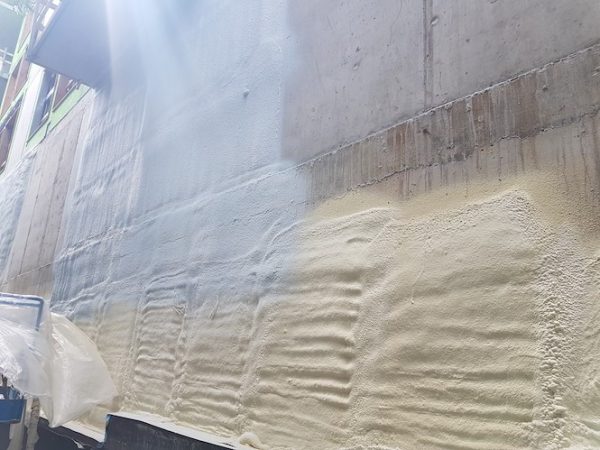
With 2020 around the corner, and year-end and first-quarter budgets under review, there is a good chance property owners and managers are looking at some renovations or energy-saving retrofit upgrades for their commercial or condo building. When looking for cost efficiencies, it’s absolutely crucial to look at the building as a whole. For instance, even if you install a state-of-the-art, high-efficiency HVAC system and smart thermostats, you could still be losing money if there is heated or cooled air escaping through your walls, windows, doors or roof. In fact, air leakage can account for up to 40 per cent of a building’s energy loss. This is why insulation and sealing should always be at the top of the priority list of things to look at.
Not all insulations are created equal
Whether upgrading or starting a new build, the insulation materials chosen should meet a certain checklist to be truly worth the investment and stand the test of time. Besides providing a high RSI (Relative Strength Index, otherwise known as thermal resistance) and air sealing, a building’s insulation should consistently perform year-round regardless of climate or season, minimize material waste and costs and meet today’s stringent building codes and environmental laws – especially if you are looking to achieve energy performance certifications such as Energy Star or LEED.
Continuous insulation
You may have heard the term “continuous insulation” or “CI” before. Now required by nearly all building codes (such as OBC 2017 in Ontario), CI is defined by ASHRAE as “insulation that is continuous across all structural members without thermal bridges other than fasteners and service openings. It is installed on the interior, exterior, or is integral to any opaque surface of the building envelope.” This means that exterior insulation, not just interior, is now something to consider.
The evolution of external air barriers used in commercial buildings is an interesting one, and a story in itself, beginning with building wraps in the 1970s (which worked, but were too much of a challenge to install properly), then self-adhered membranes (which were more reliable, but had a long installation process and depended on temperature-sensitive adhesives), followed by fluid-applied barriers, (which took less time to install, but the products themselves were often considered too expensive).
As the quest for CI continued, along with the increasing cost and number of materials employed in the exterior wall, rigid foam plastic manufacturers developed multipurpose products extruded polystyrene (XPS) and polyisocyanurate (ISO) insulation (otherwise known to most as Styrofoam insulation), which are still used to this day. However, to achieve true CI, installation needs to be meticulous, because thousands of foam board joints and tens of thousands of foam board fasteners create potential direct paths for leakage. This brings us to spray foam insulation, otherwise known as sprayed polyurethane foam (SPF), which is, for good reason, becoming an increasingly popular choice.
Spray foam insulation
Spray foam insulation products (SPF) are in demand because of their performance for both energy and operating cost savings in buildings. Thanks to its RSI value of around 6.2 to 7.4 per inch (compared to blown fibreglass with an RSI of around 3.5 to 4.0), SPF saves on both heating and cooling costs. Recently approved as an exterior air, water, and vapour barrier, it insulates and air seals walls in commercial buildings. This is because SPF ‘self-supports’ and adheres to common construction materials, including itself. It can be installed much more quickly than rigid foam board insulation, because unlike rigid foam board, it does not need to be mechanically fastened, saving both time and labour costs.
Another installation benefit of SPF is its ability to conform directly to any wall surface, regardless of its shape or texture. It can be used on the exterior or interior side of a wall (structural or sheathing) – fully covering and sealing the underlying construction, providing true continuous insulation (CI) and a tight building envelope.

Icynene platinum foam
As we know all too well, Canadian weather can be both unpredictable and ruthless – with extremely cold winters and hot summers. This is why spray foam is also one of the most energy-efficient materials for roofing, since it becomes a seamless monolithic membrane once applied – sealing the building envelope to stop heat transfer through the roof deck, while minimizing the escape of heated or cooled air and restricting untreated air from entering the building. While most roofing systems are not 100 per cent effective against water intrusion, since concrete blocks or bricks and mortar are inherently porous, it’s comforting to know that SPF (in its medium-density, closed-cell form) can act as a water-resistant barrier (WRB). Not only that, it provides an air barrier as well, keeping moist air from getting through and into the building, which helps to prevent damaging condensation. SPF is sustainable as well: since it can be applied directly on top of existing substrates, you save time and money that would have been spent on disposal costs and keep discarded material out of landfills.
Environmental standards
Besides meeting today’s green building standards and certification systems, there is another detail to be aware of when it comes to SPF: as part of the Montreal Protocol on Substances that Deplete the Ozone Layer, Canada and other developed nations have committed to replace hydrofluorocarbons (HFCs) with hydrofluorolefins (HFOs) by the year 2020. Developed by Honeywell, HFOs have an ultra-low global warming potential (GWP) and are non-ozone depleting. At the same time, Lapolla pioneered the development of a new SPF formulation that incorporated the new HFO blowing agent, and was the first to market the near-zero GWP product – which has equal effectiveness as an insulating product.
Stats show that the demand for SPF is steadily increasing, with estimates of continued growth for the foreseeable future. According to MarketWatch.com, the demand for SPF is estimated to be approximately 18-20% of the insulation market today, and is projected to reach an estimated $2.1 billion by 2023 with a CAGR (Compound Annual Growth Rate) of 5.4 per cent from 2018 to 2023.
The major growth drivers for this market are stringent government regulations for greenhouse gas emissions and the increased demand for energy efficiency in buildings. Building owners are definitely seeing the value in having in having an energy-saving airtight building and are educating themselves on SPF’s efficiencies and overall health benefits.
ROI
Updating older commercial infrastructure using SPF is an excellent investment opportunity. The energy savings add up—for example, installing a white silicone SPF roof can save up to 35 per cent on summer cooling costs. Another benefit of an SPF retrofit is occupant satisfaction, as its air and vapour barrier capabilities can help to improve both indoor environment quality (IEQ) and indoor air quality (IAQ) providing a more comfortable indoor climate and humidity level while also preventing pollutants and allergens from leaking into the indoor environment. There are lesser known benefits too, such as a quieter building (since air barriers help reduce sound transmission through the walls) and even pest control in interior walls (since it’s not considered a food source, SPF does not attract bugs, rats or mice to consume or nest in the material).
Talk with a licensed SPF commercial contractor to find out which SPF product is right for every commercial retrofit or design project. They can provide the technical support, engineering codes and design details required to get it done.

Doug Kramer
Doug Kramer has been a leading figure in the spray foam insulation and roofing products industry for almost 30 years with manufacturing, operations, sales and marketing experience in a broad variety of elastomeric coatings and polyurethane foam for construction. He is currently the president/CEO of Icynene-Lapolla, two long-standing SPF brands that merged to provide a strong unified approach to deliver superior products, technical knowledge, customer service and sales support to Icynene’s and Lapolla’s customers and consumers.
Print this page